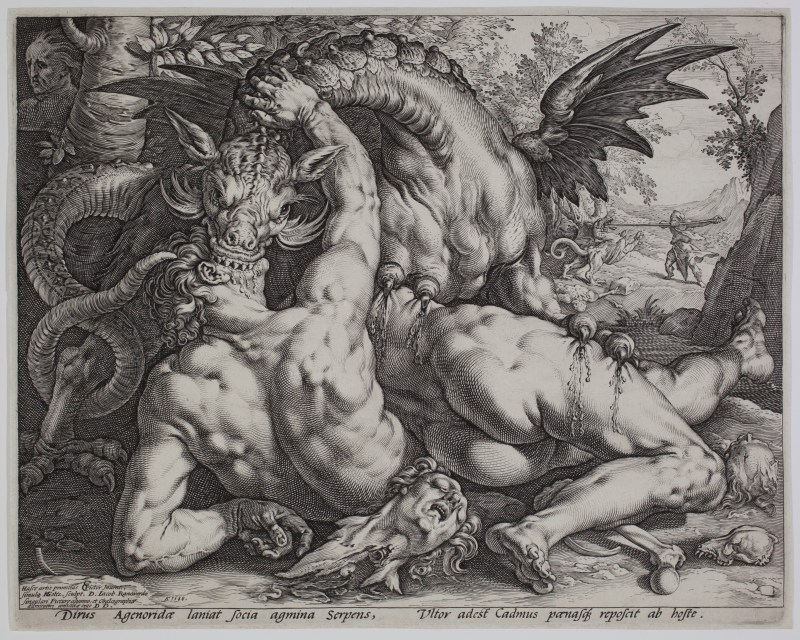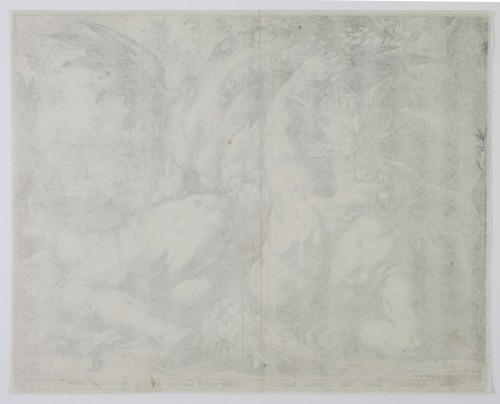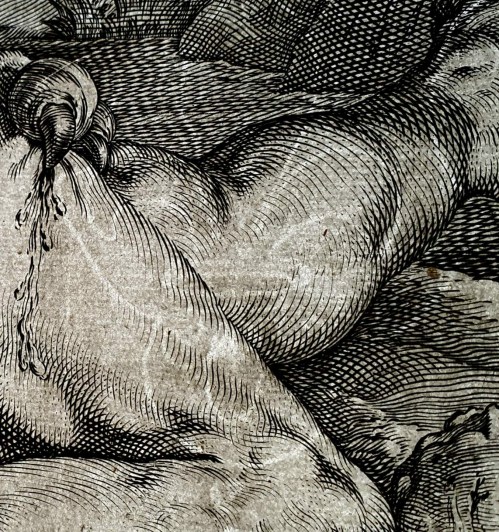Hendrick GOLTZIUS: The Dragon devouring the Companions of Cadmus - 1588
Price: € 28 000
Engraving, 253 x 320 mm. Bartsch 262; Strauss 261; New Hollstein 329, 1st state (of 4).
Impression of the 1st state (of 4) before the address of Claes Jansz. Visscher (1587-1652).
Very fine impression printed on watermarked laid paper. Watermark: variant of Simple fleur-de-lys in a crowned coat of arms (Briquet 7210: Leyde 1585, Amsterdam 1590-1599). This sort of watermark is quoted by Walter L. Strauss for impressions of the 1st state. Generally in very good condition. Small thin areas on the reverse along the right border of the sheet. Thread margins all around the platemark (sheet: 258 x 322 mm).
The Dragon Devouring the Companions of Cadmus is one of the most striking Mannerist engravings by Hendrick Goltzius, who engraved in reverse a picture painted in the same year by Cornelis Corneliszoon van Haarlem, now in the National Gallery in London (inv. no. NG1893). The two artists were very close and founded a kind of academy of fine arts in Haarlem with Karel van Mander around 1583-1584. In 1588, Goltzius was the first to produce engravings after the designs of Cornelis van Harlem.
The Dragon Devouring the Companions of Cadmus is dedicated to the Amsterdam collector and art dealer Jacob Engbertsz. Rauwaert. In the dedication, Goltzius associates Cornelis van Haarlem as joint contributor: Hasce artis primitias CCPictor Invent.[or], / simulq[ue] HGoltz. sculpt.[or] D. Iacob. Raeuwerdo / singulari Picture alumno, et Chalcographiae / admiratori amicitiae ergo D[ono] D.[ederunt], "The painter C[ornelis] C[orneliszoon], inventor of the design, and Hendrick Goltzius, who engraved it, together offer these beginnings of their art as a token of their friendship to Lord Jacob Rauwaert, a gifted student of painting and admirer of engraving." (our translation).
That year, Goltzius also engraved the series of The Four Disgracers, Tantalus, Icarus, Phaeton and Ixion, after designs by Cornelis van Haarlem. Julie McGee observes that these four plates and The Dragon Devouring Cadmos' Companions have a similar theme: condemned sinners and the disgraced, a theme that was then enjoying a vogue in Haarlem. Both works are characterised by an over-the-top mannerist style which Goltzius and Cornelis van Haarlem popularised in the Netherlands: the exaggeratedly muscular bodies pictured under improbable angles in The Four Disgracers find an echo in the truncated body parts of Cadmus' companions: they are so contorted that it is difficult to understand that the bust on the left does not belong to the lower body on the right. In The Four Disgracers, a feeling of dereliction was inspired by the fatal fall of bodies; here we experience horror and repulsion at the sight of the mutilated bodies: a head that has been torn off lying in the foreground, bones stripped of flesh, blood pouring out of the wounds opened by the claws of the monster. The beast is shown devouring the face of a victim who is still trying to defend himself, while it stares at the spectator. The happy ending of the story is relegated to the background: Cadmus, who can be seen on the right, killing the dragon, survives his companions and then goes on to found the city of Thebes.
Reference: Julie L. McGee: Cornelis Corneliszoon van Haarlem (1562 - 1638), Patrons, Friends and Dutch Humanists, 1991.





